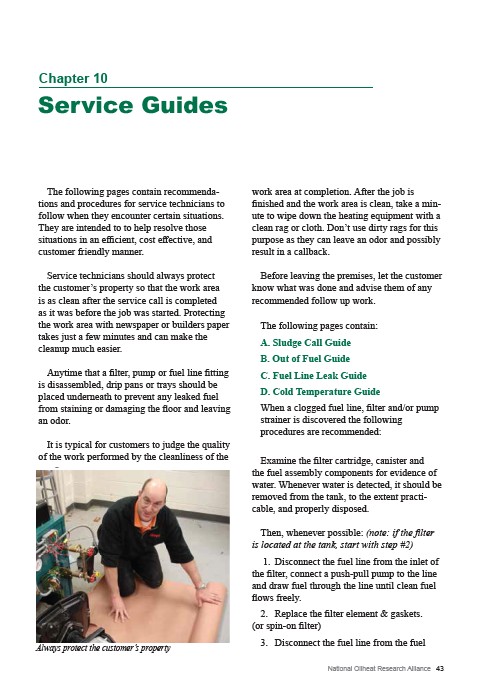
National Oilheat Research Alliance 43
Chapter 10
Service Guides
The following pages contain recommendations
and procedures for service technicians to
follow when they encounter certain situations.
They are intended to to help resolve those
situations in an efficient, cost effective, and
customer friendly manner.
Service technicians should always protect
the customer’s property so that the work area
is as clean after the service call is completed
as it was before the job was started. Protecting
the work area with newspaper or builders paper
takes just a few minutes and can make the
cleanup much easier.
Anytime that a filter, pump or fuel line fitting
is disassembled, drip pans or trays should be
placed underneath to prevent any leaked fuel
from staining or damaging the floor and leaving
an odor.
It is typical for customers to judge the quality
of the work performed by the cleanliness of the
work area at completion. After the job is
finished and the work area is clean, take a minute
to wipe down the heating equipment with a
clean rag or cloth. Don’t use dirty rags for this
purpose as they can leave an odor and possibly
result in a callback.
Before leaving the premises, let the customer
know what was done and advise them of any
recommended follow up work.
The following pages contain:
A. Sludge Call Guide
B. Out of Fuel Guide
C. Fuel Line Leak Guide
D. Cold Temperature Guide
When a clogged fuel line, filter and/or pump
strainer is discovered the following
procedures are recommended:
Examine the filter cartridge, canister and
the fuel assembly components for evidence of
water. Whenever water is detected, it should be
removed from the tank, to the extent practicable,
and properly disposed.
Then, whenever possible: (note: if the filter
is located at the tank, start with step #2)
1. Disconnect the fuel line from the inlet of
the filter, connect a push-pull pump to the line
and draw fuel through the line until clean fuel
flows freely.
2. Replace the filter element & gaskets.
(or spin-on filter)
3. Disconnect the fuel line from the fuel Always protect the customer’s property